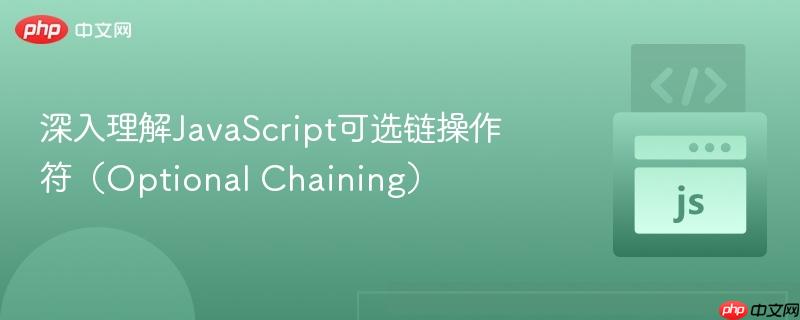
javascript的可选链操作符(`?.`)提供了一种安全访问对象属性或调用函数的方式。当尝试访问的属性或方法所属对象为`null`或`undefined`时,它会短路并返回`undefined`,而非抛出错误,从而增强了代码的健壮性和可读性。
在现代JavaScript开发中,我们经常需要处理来自不同源的数据,这些数据结构可能不总是完全一致,或者某些属性可能缺失。直接访问一个不存在的属性或对null/undefined值进行属性访问,会导致程序抛出TypeError,中断执行。可选链操作符(Optional Chaining)正是为了解决这一痛点而引入的ES2020(ES11)新特性。
可选链操作符(?.)允许开发者在尝试访问一个可能为null或undefined的对象的属性或方法时,不必进行冗长的null或undefined检查。如果链中的某个引用是null或undefined,表达式会立即短路并返回undefined,而不是抛出错误。
它的基本语法有以下几种形式:
在可选链操作符出现之前,为了安全地访问深层嵌套的属性,我们通常需要编写一系列的条件判断,例如:
立即学习“Java免费学习笔记(深入)”;
// 传统方式,没有可选链
const user = {
profile: {
address: {
street: 'Main St'
}
}
};
// 假设profile或address可能不存在
let streetName;
if (user && user.profile && user.profile.address) {
streetName = user.profile.address.street;
} else {
streetName = undefined; // 或者其他默认值
}
console.log(streetName); // Main St
const anotherUser = {};
let anotherStreetName;
if (anotherUser && anotherUser.profile && anotherUser.profile.address) {
anotherStreetName = anotherUser.profile.address.street;
} else {
anotherStreetName = undefined;
}
console.log(anotherStreetName); // undefined这种方式代码冗长且可读性差。而有了可选链,代码将变得简洁明了:
// 使用可选链
const user = {
profile: {
address: {
street: 'Main St'
}
}
};
const streetName = user?.profile?.address?.street;
console.log(streetName); // Main St
const anotherUser = {};
const anotherStreetName = anotherUser?.profile?.address?.street;
console.log(anotherStreetName); // undefined我们以一个常见的场景为例:从URL查询字符串中提取特定参数。
假设我们有一个URL,其中可能包含type参数,我们想获取它的值。
const { search } = useLocation(); // 假设useLocation()返回当前URL的location对象,search属性为查询字符串
// search 可能是 "?param1=value1&type=someType" 或者只是 "?param1=value1"
const match = search.match(/type=(.*)/);
// 如果search字符串中包含"type=",match将是一个数组,如 ["type=someType", "someType", index: ..., input: ..., groups: ...]
// 如果search字符串中不包含"type=",match将是 null现在,我们想获取匹配到的type值,它通常位于match数组的第二个元素(索引为1)。
没有可选链的情况:
如果search字符串不包含type参数,那么match变量将是null。此时,尝试直接访问match[1]会抛出TypeError:
const search = "test"; // 模拟一个不包含"type="的查询字符串
const match = search.match(/type=(.*)/); // 此时 match 为 null
// 尝试访问 match[1] 会导致错误
try {
const type = match[1];
console.log(type);
} catch (error) {
console.error("发生错误:", error.message); // 输出: 发生错误: Cannot read properties of null (reading '1')
}使用可选链的情况:
通过在match变量后使用可选链操作符?.,我们可以安全地访问其属性:
const search = "test"; // 模拟一个不包含"type="的查询字符串 const match = search.match(/type=(.*)/); // 此时 match 为 null const type = match?.[1]; // 使用可选链安全访问 console.log(type); // 输出: undefined
在这个例子中,当match为null时,match?.[1]表达式会短路,直接返回undefined,而不是抛出错误。这使得代码更加健壮,无需额外的if (match)判断。
并非替代所有null检查:可选链主要用于处理“可能不存在”的属性或方法。如果某个属性或对象在逻辑上是“必须存在”的,并且其缺失表示程序错误,那么直接抛出错误(不使用可选链)可能更合适,以便及时发现并修复问题。
与空值合并操作符(??)结合使用:可选链返回undefined时,可以与空值合并操作符(??)结合,为缺失的值提供一个默认值。
const user = {};
const userName = user?.profile?.name ?? 'Guest';
console.log(userName); // Guest函数调用:可选链也可用于安全地调用可能不存在的函数。
const obj = {
method: () => console.log('Method called!')
};
obj.method?.(); // 输出: Method called!
const anotherObj = {};
anotherObj.method?.(); // 不会报错,也不会执行任何操作避免过度使用:虽然可选链很方便,但过度使用可能掩盖数据结构设计问题。在某些情况下,通过类型检查或数据预处理来确保数据完整性可能更优。
可选链操作符(?.)是JavaScript中一个强大且实用的新特性,它极大地简化了对可能为null或undefined的对象属性和方法的访问。通过减少冗余的条件判断,它提高了代码的简洁性、可读性和健壮性,是现代JavaScript开发中不可或缺的工具。掌握并合理运用可选链,能够帮助我们编写出更加优雅和可靠的代码。
以上就是深入理解JavaScript可选链操作符(Optional Chaining)的详细内容,更多请关注php中文网其它相关文章!

每个人都需要一台速度更快、更稳定的 PC。随着时间的推移,垃圾文件、旧注册表数据和不必要的后台进程会占用资源并降低性能。幸运的是,许多工具可以让 Windows 保持平稳运行。

Copyright 2014-2025 https://www.php.cn/ All Rights Reserved | php.cn | 湘ICP备2023035733号